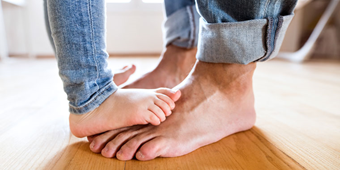Not For Women Only: Osteoporosis Affects Men, Too

Find Your Perfect Match
Answer a few questions and we'll provide you with a list of primary care providers that best fit your needs.
You can’t feel or see your bones thinning. And if you’re a man, you probably haven’t given much thought to the possibility of having osteoporosis. Most of us think of it as a disease that affects women. Yet, more than two million men in the U.S. have this condition marked by brittle, fragile bones. An additional three million men have osteopenia, a less severe thinning of bones that can lead to osteoporosis.
If you are a man age 50 or older, you have a one in four chance of breaking a bone due to osteoporosis, according to the National Osteoporosis Foundation. Those odds are greater than the odds of getting prostate cancer. The hip, spine, and wrist bones are the most common bones to break.
Throughout life, new bone cells replace old ones. Bone mass peaks for most people around age 30, and men tend to have more bone mass than women. After age 30, more bone is lost than made.
Men don’t tend to have a sudden drop in bone mass like women do with menopause. By age 70, however, men and women lose bone at the same rate and experience a decline in calcium absorption, which is essential to bone health.
Start Prevention Strategies Early
Prevention is the best treatment for osteoporosis. The National Osteoporosis Foundation recommends taking these actions to strengthen bones and lessen your chances of developing the disease:
- Avoid smoking
- Don’t drink more than two to three alcoholic drinks a day
- Eat a well-balanced diet, with plenty of calcium and vitamin D
- Exercise regularly, including both weight-bearing and muscle strengthening exercise
Consider Your Risk Factors
Although being a man is an advantage when it comes to osteoporosis, there are certain lifestyle behaviors, health conditions, and medications that contribute to bone loss.
Your risk of developing osteoporosis increases with age. You are also at greater risk if you:
- Take glucocorticoid (steroid) medications, used for diseases such as asthma and rheumatoid arthritis. Bone loss is a common side effect of these medications.
- Take chemotherapy drugs that suppress the immune system and contribute to bone loss
- Have low testosterone levels, which accelerate bone loss
- Have a chronic disease that affects the kidneys, lungs, stomach, and intestines or alters hormone levels
- Drink too much alcohol or smoke
- Don’t engage in weight-bearing activities, such as walking or weightlifting
Diagnosing And Treating Osteoporosis
If you or your doctor suspects that you have enough factors to be at risk for osteoporosis, the most important test you can have is a bone mineral density scan. The most common type is a central DXA (dual-energy x-ray absorptiometry) scan of the hip and spine. The test is painless, safe, and requires no preparation.
If your bone mass is below normal, you can take steps to treat osteopenia or osteoporosis.
Treatments include:
Medications. There are medicines that slow bone loss and others that increase bone formation. If your bone loss is due to steroid use, your doctor may reduce your dosage or prescribe a medicine designed to prevent or treat glucocorticoid-induced osteoporosis.
Calcium and vitamin D. Getting enough calcium and vitamin D through food or supplements is essential to building strong bone. According to the National Institutes of Health, recommended calcium intake for males ages 19 to 70 is 1,000 mg per day. After age 70, 1,200 mg per day is preferred. Vitamin D consumption should be 600 IU per day for males from childhood through age 70. It should increase to 800 IU per day after age 70.
Addressing underlying conditions. If conditions such as testosterone deficiency or stomach or intestinal problems are contributing to osteoporosis, your doctor will likely design a treatment plan to address those issues.
Lifestyle choices. As mentioned, healthy eating, weight-bearing exercise, and avoiding smoking and excessive alcohol all contribute to stronger bones.
Find Your Perfect Match
Answer a few questions and we'll provide you with a list of primary care providers that best fit your needs.
Source: National Institutes of Health; National Osteoporosis Foundation




